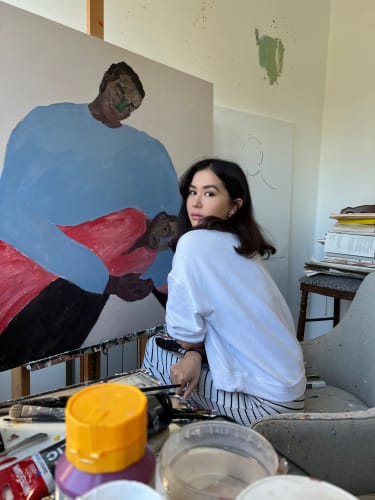"The energy and emotion in my paintings is always positive. There is too much pain and grief in the world already."
Such is the artistic mantra of Aisulu N. (Ais). Born in Almaty, the largest city in Kazakhstan, in 1982, she says that bringing happiness to viewers and collectors of her work is the reason she puts paint to canvas.
Ais studied at SMFA at Tufts University in Boston, where she completed a post-baccalaureate program in fine arts. Her early pictures were in an abstract manner, but she has since established herself as one of the leading figurative painters.
Executed in a faux naïf style, her typical works are colourful scenes, depicting individuals or couples in understatedly elegant clothes. She says that her subjects aren’t actual people, so much as a mixture of emotions, memories and values evoked in the act of painting. Often prominent in that mixture is tenderness: shown both by the painter towards her figures and, in the case of twin subjects, between each other.
Aisulu has lived in countries around the world such as the United States, France and Singapore. She counts a number of artists as influences. These include Marlene Dumas, Egon Schiele, Alice Neel and Peter Doig, in large part because of their sustained dedication to figuration; their bold use of colour; and their storytelling instincts. (Ais likes each of her own canvases to have – or, at least, to suggest – some kind of narrative.)
She also appreciates what she calls the "humility before the canvas” that those other painters demonstrated. In her view, no matter how much success comes an artist’s way, one must show one’s medium respect at all times.
Though admitting that the history and culture of Kazakhstan may have infused her art in a handful of small, unobserved ways, Aisulu says that what she strives for is universality: paintings that will appeal to people across the globe. To that end, her subjects appear in a variety of sizes and colours, and tend to give off a quiet sense of contentment. Her choice of titles – ranging from "I Have a Wish" and "It’s a Special Evening for Us" to "I will Never Let you down, my Bestie" – reflect that.
Her scenes have little in the way of accoutrements or background. There’s a certain simplicity to them – simplicity, in the artist’s opinion, being an antidote to the materialism that pervades much of modern society.
Many of her subjects do, it's true, hold flowers. In Aisulu’s universe, however, flora don’t symbolise mortality or the transience of human existence as they do in still-life paintings of the 17th Century. Rather, they celebrate the experience of being alive, well and blossoming.
"My art is about light and love and togetherness," Ais says. "This is what truly matters. I want people to feel good."
